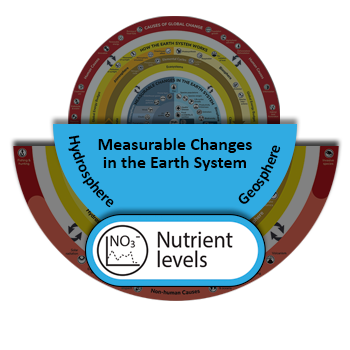Nutrients are substances that provide nourishment for organisms. They can be derived from other organisms, for example protein or vitamins, or from inorganic sources. Here we focus on inorganic sources, such as the chemical elements nitrogen and phosphorus, which are necessary for sustaining life. Chemical nutrients cycle through abiotic parts of the Earth system and within the biosphere through species interactions. The availability of chemical nutrients affects soil quality, agricultural activities, and regional productivity and biomass.

Scientists collect and analyze water samples to determine how nutrient levels affect algae growth. Source: USGS
Chemical nutrient levels can vary significantly in aquatic and terrestrial habitats, and can be affected by various human activities and environmental phenomena, including:
- The rock cycle, especially rates of weathering and erosion. Different rock types have different concentrations of chemical nutrients. Thus, the type of rock that is weathered plays a major role in determining the type and concentration of nutrients in soils, freshwater environments, and coastal waters. These nutrient levels, in turn, can influence which species of plants and animals are present.
- Increased precipitation can increase erosion and thus the transport of chemical nutrients into soils, freshwater environments, and coastal waters.
- Soils often contain high chemical nutrient levels. Thus, deforestation, habitat loss, and erosion can reduce the nutrient levels in terrestrial ecosystems.
- The use of fertilizers for agricultural activities typically increases the amount of chemical nutrients in soil or water, especially nitrogen and phosphorous. These nutrients increase plant and algae growth, including growth of species that are toxic to other organisms. Increased nutrient is not always a good thing. For, example, in aquatic environments, nutrient-rich runoff can cause large amounts of algae grow. When these algae die, they are consumed by bacteria which can reduce oxygen levels in the water, killing fish and other species. This process is known as eutrophication.
- Changes in ocean circulation patterns can alter the concentration and distribution of nutrients that are transported offshore. Dissolved chemical nutrients, especially nitrogen and phosphorus, are critical for marine organisms, including the growth of plankton and algae which form the base of most ocean food webs. When organisms die they sink to the bottom of the ocean where their nutrients are released as they decay. These nutrients can be returned to the surface by ascending currents through a process known as upwelling caused by offshore winds. Regions with coastal upwelling have highly productive ecosystems.
- Changes in atmospheric circulation patterns can alter the concentration and distribution of dust (airborne particles) that contain nutrients for life on land and in aquatic environments.
Can you think of additional cause and effect relationships between nutrient levels and other parts of the Earth system?
Visit the soil quality, erosion, and elemental cycles pages to explore more connections between the biosphere, geosphere, and other global changes.
Investigate
Learn more in these real-world examples, and challenge yourself to construct a model that explains the Earth system relationships.
